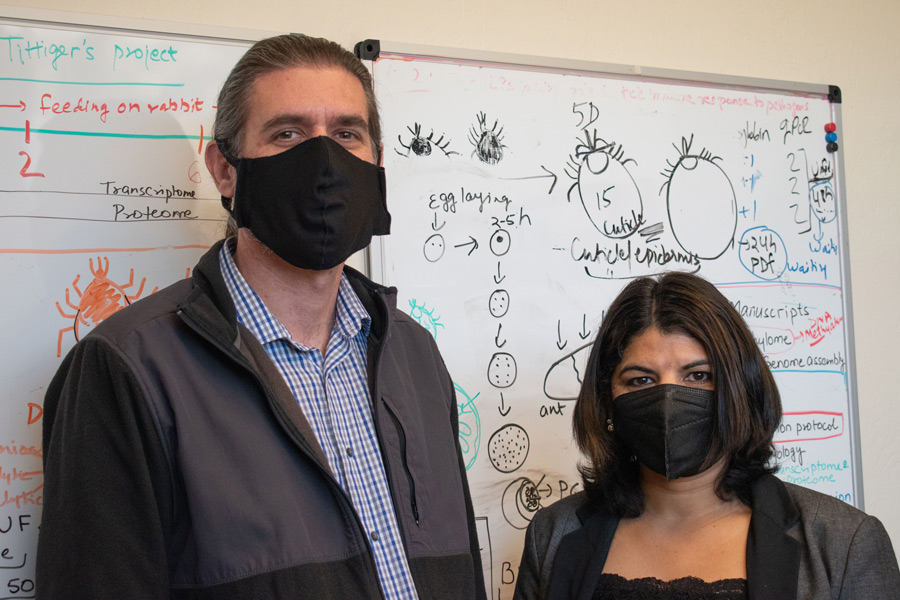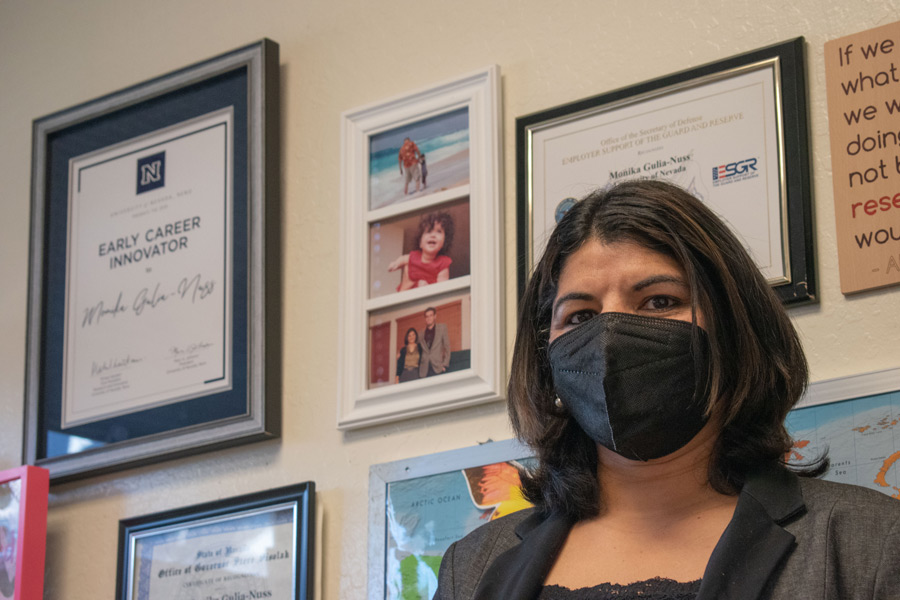Ticks are more than an inconvenience. Dangerous and potentially fatal tick-borne diseases such as Lyme disease are on the rise in the United States, Canada and Europe, posing threats to anyone who works or recreates outdoors. A research collaboration led by Monika Gulia-Nuss, assistant professor in the Department of Biochemistry & Molecular Biology at the University of Nevada, Reno, has developed ground-breaking gene-editing for ticks that could mitigate this public health concern by decreasing the ability of ticks to be a vector for disease and pathogen transition.
The research team’s latest discovery, published in iScience Journal, is a new protocol that allows gene editing at the embryo stage in ticks, previously thought to be impossible.
 Andrew Nuss and Monika Gulia-Nuss.
Andrew Nuss and Monika Gulia-Nuss. The Gulia-Nuss lab was joined in this research by Andrew Nuss, assistant professor in the Department of Agriculture, Veterinary & Rangeland Sciences and his lab from the University of Nevada, Reno, along with researchers from The Pennsylvania State University’s Center for Infectious Disease Dynamic and University of Maryland’s Institute for Bioscience and Biotechnology Research. The research was funded by the National Institutes of Health and the project was further assisted by the Nevada Bioinformatics Center at the University of Nevada, Reno.
In this study, the researchers successfully carried out targeted gene disruption in ticks with CRISPR-Cas9 using two methods: embryo injection and Receptor-Mediated Ovary Transduction of Cargo (ReMOT Control), a less labor-intensive method of gene-editing in arthropods first developed in insects by collaborator Jason Rasgon at Penn State.
While Lyme disease is the most common tick-borne disease, there are at least 20 different infections that are transmitted by ticks in the U.S. More than 300,000 new cases of Lyme disease are diagnosed each year, and the number of new cases and the areas where ticks are found are increasing.
“Ticks are a public health nuisance. They transmit many pathogens that can cause diseases in humans, companion animals and wild animals,” said Gulia-Nuss, a recipient of the University’s Early Career Innovator Award in 2019. “We need to understand the biology of ticks on a molecular level. If we understand the [tick] vectors better, we can find new ways to manage ticks and tick-borne diseases as well, either through acaricide, vaccines or drug development.”
Finding a solution
Gulia-Nuss’s work has attracted the attention of the Congressionally established Tick-Borne Disease Working Group, which invited her to present her public-impact research and pioneering findings at their most recent meeting on Dec. 8, 2021. She described this as a “great experience” where she could elaborate on how the methods they are developing can lead to new and significant developments in the tick research space.
“This is the first time ticks have been modified in any way on the genetic level, so that was really interesting for the committee,” said Gulia-Nuss. “The committee members wanted to hear more about [our group’s] work and how this could be applicable to different areas of tick-borne disease research.”
Together Gulia-Nuss’ and Andrew Nuss’ labs are the first to develop the embryo injection protocol for gene editing for ticks. With this new development, researchers can start editing any gene in the genome, allowing them to ask questions that were not possible to answer before. For example, when editing or removing certain genes, they can examine what happens to the tick and if this alteration interferes with the pathogen development in a way that makes it harmless to humans.
The discovery did not come without its challenges. A major struggle that Gulia-Nuss described was developing a way to inject tick eggs. Ticks are unique because they put a large amount of wax on their eggs, and that wax must be removed before the researchers can successfully inject the embryo without killing the egg. Collaboration with Robert Harrell, of the University of Maryland and an expert in insect embryo injections, was important for finding appropriate injection conditions for tick embryos.
“By modifying ticks at a genetic level to try to reduce the incidence of Lyme disease, Monika and her collaborators provide an excellent example of the kind of groundbreaking research we do at this University to have real impact on a public health issue. We’re grateful to have them on our team," said Bill Payne, dean, College of Agriculture, Biotechnology & Natural Resources.
The solution came about during a collaborative visit by Harrell to the University of Nevada, Reno, during which he, Gulia-Nuss and Andrew Nuss considered tick biology and a gland in ticks that produces the wax and covers the eggs in it. They hypothesized that if they could remove the gland, their wax problem would be solved. This ended up being correct, resulting in a “technological breakthrough,” Gulia-Nuss said.
Andrew Nuss said learning from others’ past research on genetic transformation played a huge role in their eventual breakthrough. He said that by looking at what has and hasn’t worked, their labs gained valuable insight that informed their research.
Gulia-Nuss hopes that as their labs continue to develop these methods, they will evolve enough where other labs outside of the University can easily use them. With the expertise and collaborative efforts of more researchers, more progress can be achieved in tick research, eventually reducing the tick-borne disease threat.
“Together we stand stronger,” she said.
Collaboration and community
A great degree of collaboration from local, regional and other University partners makes Gulia-Nuss’ work successful. She and Andrew Nuss are part of a National Science Foundation multistate grant, joining four other University faculty and 11 other researchers at other universities. This group has a diverse range of specialties, including computational biologists, geologists, modelers and video game developers. Gulia-Nuss expressed the importance of having different experts on a team.
“No one is an expert in everything. Together, we are trying to understand ticks and tick-borne diseases dynamics in the Pacific West, specifically,” she said. “A lot of work has been done on the East Coast because Lyme disease is most prevalent in the Northeast and Midwest, but there’s not a whole lot of work being done on the West Coast of the United States, so we’re trying to fill that gap through the NSF grant.”
The husband and wife team are part of the biology team within the group, so their role is to work toward understanding different populations of ticks and associated pathogens. They ask questions such as: Are ticks from varying geographical areas different? What pathogens are associated with these ticks? Are there any unique pathogens that are only in this area?
Another important aspect of their work involves going out into the field several times a year. This fieldwork usually involves members from four different labs at the University – labs directed by Gulia-Nuss; Andrew Nuss; Claudia Rückert, assistant professor in the Department of Biochemistry & Molecular Biology; and Mike Teglas, professor in the Department of Agriculture, Rangeland, and Veterinary Sciences – collecting ticks from different areas in the Western United States. They use a white cloth fabric and drag it across the area’s vegetation, collecting the ticks that latch onto the cloth.
The public often assists in the collection of ticks as well. While they are not directly involved in collection efforts, volunteers from the public can send in ticks they find while outdoors to their labs. If lab members see anyone in their collection area, they offer them collection kits if they’d like to participate. Other regional collaborators, such as the California Department of Public Health and Vector Control districts, also assist by sending in ticks.
“It expands our capabilities,” Andrew Nuss said. “We can’t be everywhere at once. We’re a small team. But the public can certainly help. If they find a tick on themselves, or on their dog, that really can increase the number of samples we get, and coverage of areas as well.”
“It helps us a lot because we don’t know all the areas where ticks can be found, and the public can help notify us as to where ticks are,” Gulia-Nuss added.
This fieldwork also acts as an opportunity for Gulia-Nuss and others to educate the public about the prevalence of ticks and tick-borne diseases. While out, she said they want to help others understand that tick life stages are present in these areas all the time, throughout the year, not just in summer or fall.
As Gulia-Nuss and her collaborators continue their important research, she said there will always be something new to discover.
“Every day we find something new that we haven’t thought about,” she said. “The most fascinating part about the work is pushing the boundaries, making new tools for arthropod research, involving the public in our research through citizen scientist projects, training and mentoring the next generation of scientists.”















